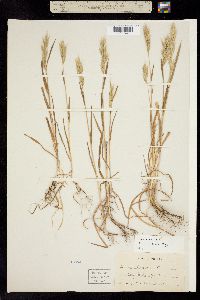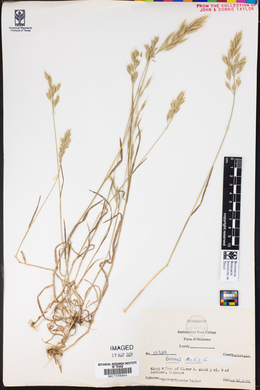Bromus hordeaceus
|
|
|
|
Family: Poaceae
Soft Brome, more...soft chess, Brome Mou, Lopgrass
[Bromus hordeaceus f. leiostachys (Hartm.) Hyl., moreBromus hordeaceus f. leptostachys (Pers.) Wiegand, Bromus hordeaceus subsp. mollis (L.) Hyl., Bromus hordeaceus var. leptostachys (Pers.) Beck, Bromus hordeaceus var. mollis (L.) Fiori, Bromus leptostachys var. pubescens Fouill. ex de Lesd., Bromus megapotamicus Spreng., Bromus mollis f. nanus (Weigel) Todor, Bromus mollis subsp. hordeaceus (L.) Hiitonen, Bromus mollis var. hordeaceus (L.) FRIES, Bromus mollis var. leptostachys Pers., Bromus mollis var. nanus (Weigel) Lilj., Bromus nanus Weigel, Bromus secalinus var. hordeaceus (L.) L.] |
Plants annual or biennial. Culms 2-70 cm, erect or ascending. Lower sheaths densely, often retrorsely pilose; upper sheaths pubescent or glabrous; ligules 1-1.5 mm, hairy, obtuse, erose; blades 2-19 cm long, 1-4 mm wide, abaxial surfaces glabrous or hairy, adaxial surfaces hairy. Panicles 1-13 cm long, 1-4 cm wide, erect, usually ovoid, open, becoming dense, occasionally reduced to 1 or 2 spikelets; branches shorter than the spikelets, ascending to erect, straight or almost so. Spikelets (11)14-20(23) mm, lanceolate, terete to moderately laterally compressed; florets 5-10, bases concealed at maturity; rachilla internodes concealed at maturity. Glumes pilose or glabrous; lower glumes 5-7 mm, 3-5-veined; upper glumes 6.5-8 mm, 5-7-veined; lemmas 6.5-11 mm long, 3-5 mm wide, lanceolate, chartaceous, antrorsely pilose to pubescent, or glabrous proximally or throughout, 7-9-veined, lateral veins prominently ribbed, rounded over the midvein, hyaline margins abruptly or bluntly angled, not inrolled at maturity, apices acute, bifid, teeth shorter than 1 mm; awns 6-8 mm, usually arising less than 1.5 mm below the lemma apices, straight to recurved at maturity; anthers 0.6-1.5 mm. Caryopses equaling or shorter than the paleas, thin, weakly inrolled to flat. 2n = 28. Bromus hordeaceus is native to southern Europe and northern Africa. It is weedy, growing in disturbed areas such as roadsides, fields, sandy beaches, and waste places, and can be found in many locations in the Flora region, with the exception of the central Canadian provinces and most of the southeastern United States. Its origin is obscure. Ainouche et al. (1999) reviewed various suggestions, and concluded that at least one of its diploid ancestors may have been an extinct or undiscovered species related to B. caroli-henrici, a diploid species. The four subspecies are usually morphologically distinct. Ainouche et al. (1999), however, found no evidence of genetic differentiation among them. FNA 2007 Common Name: soft brome Duration: Annual Nativity: Non-Native Lifeform: Graminoid General: Annual or biennial with erect to ascending stems 2-70 cm, lower sheaths densely retrorsely pilose, upper sheaths pubescent to glabrous. Vegetative: Blades 2-19 cm long, 1-4 mm wide, lower surfaces glabrous or hairy, upper hairy; ligules 1-1.5 mm, ciliate, obtuse, erose. Inflorescence: Erect panicle 1-13 cm long, 1-4 cm wide, usually ovoid, open, becoming dense, rarely reduced to 1 or 2 spikelets; branches shorter than spikelets, ascending to erect, spikelets 14-20 mm, lanceolate, terete to moderately laterally compressed with 5-10 florets, bases concealed at maturity; glumes subequal, pilose or glabrous; lower 5-7 mm, 3-5 veined, upper 6.5-8 mm, 5-7 veined, lemmas 6.5-11 mm long, 3-5 mm wide, lanceolate, papery, pilose to pubescent, or glabrous throughout, apices acute, bifid with teeth shorter than 1 mm, awns 6-8 mm, arising less than 1.5 mm below the lemma apices, straight to recurved at maturity. Ecology: Found in disturbed areas from 2,500-7,500 ft (762-2286 m); flowers April-June. Notes: In our region we have ssp. hordeaceus which is distinguished by its lemmas being longer (8-11 mm) and pubescent to pilose, while the awns are more than 0.1 mm wide at the base, straight and erect, with stems 10-70 cm long. Ethnobotany: Seeds parched, ground into meal and made into gruel. Etymology: Bromus is from Greek bromo, for stinking, while hordeaceus means having a resemblance to barley. Synonyms: None Editor: SBuckley, 2010 Annual or sometimes biennial, 3-10 dm; culms glabrous or often puberulent; sheaths and blades hairy, the latter 2-6 mm wide; ligule 0.5-2 mm; infl rather dense, erect, 3-10 cm, its branches usually shorter than the spikelets; spikelets 10-25 mm, 6-9-fld, soft-hairy or rarely glabrous; first glume 5-7 mm, 3(5)-veined; second glume broader, 5-9-veined, 6-9 mm, often awned; lemmas 7-11 mm, ca 7-veined, 1.5-2.2 mm wide on a side, the terminal teeth 1-1.5 mm; awns straight, erect, 3-9 mm; palea shorter than the lemma; anthers 0.2-2 mm; 2n=28. Native of Europe, sparingly intr. in our range in disturbed sites. (B. mollis) Gleason, Henry A. & Cronquist, Arthur J. 1991. Manual of vascular plants of northeastern United States and adjacent Canada. lxxv + 910 pp. ©The New York Botanical Garden. All rights reserved. Used by permission. From Flora of Indiana (1940) by Charles C. Deam In 1913 I found this species to be frequent along the roadside near the water works in Michigan City, La Porte County. ...... Indiana Coefficient of Conservatism: C = null, non-native Wetland Indicator Status: UPL |
|
|
|






















































































